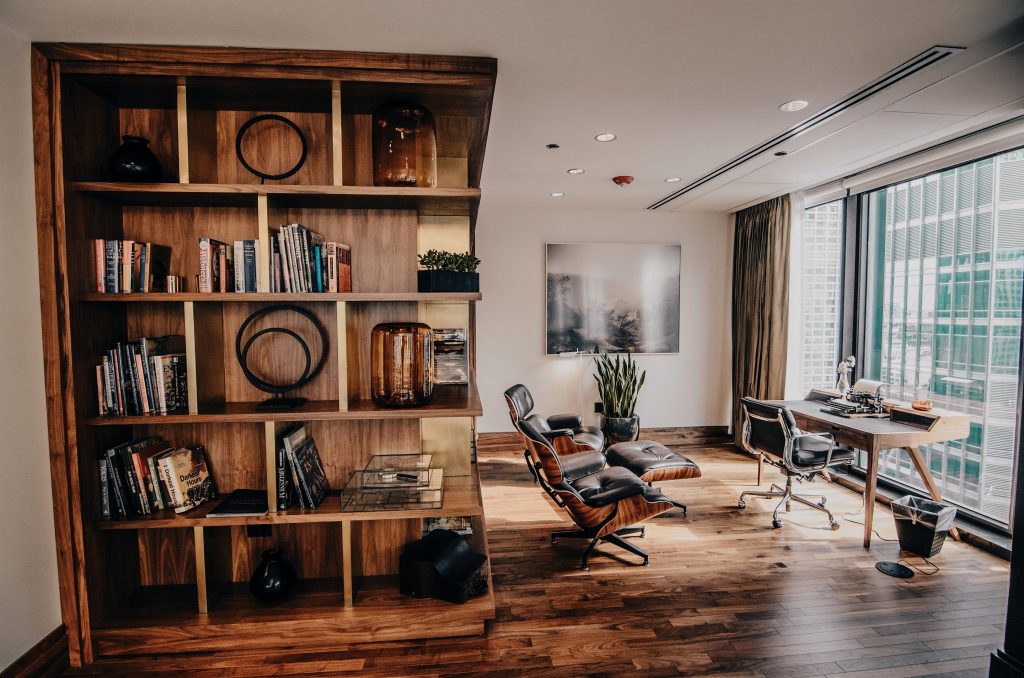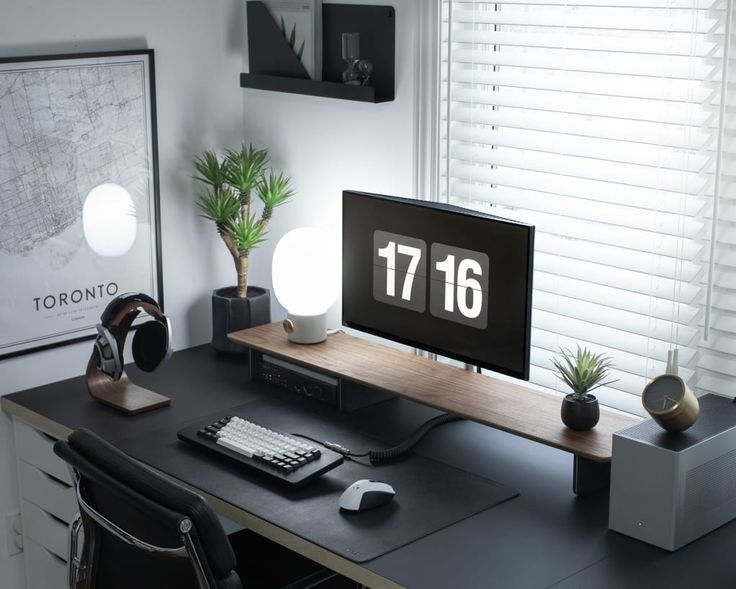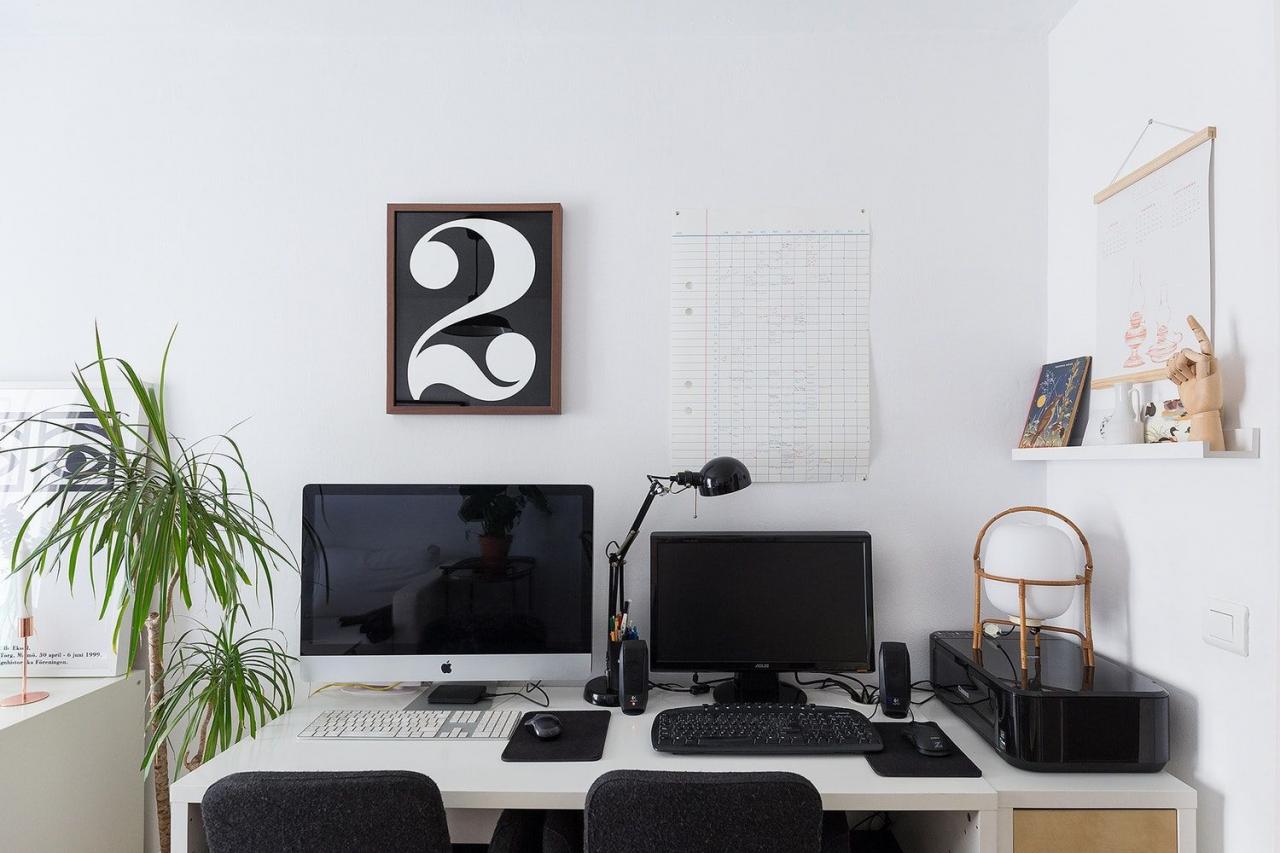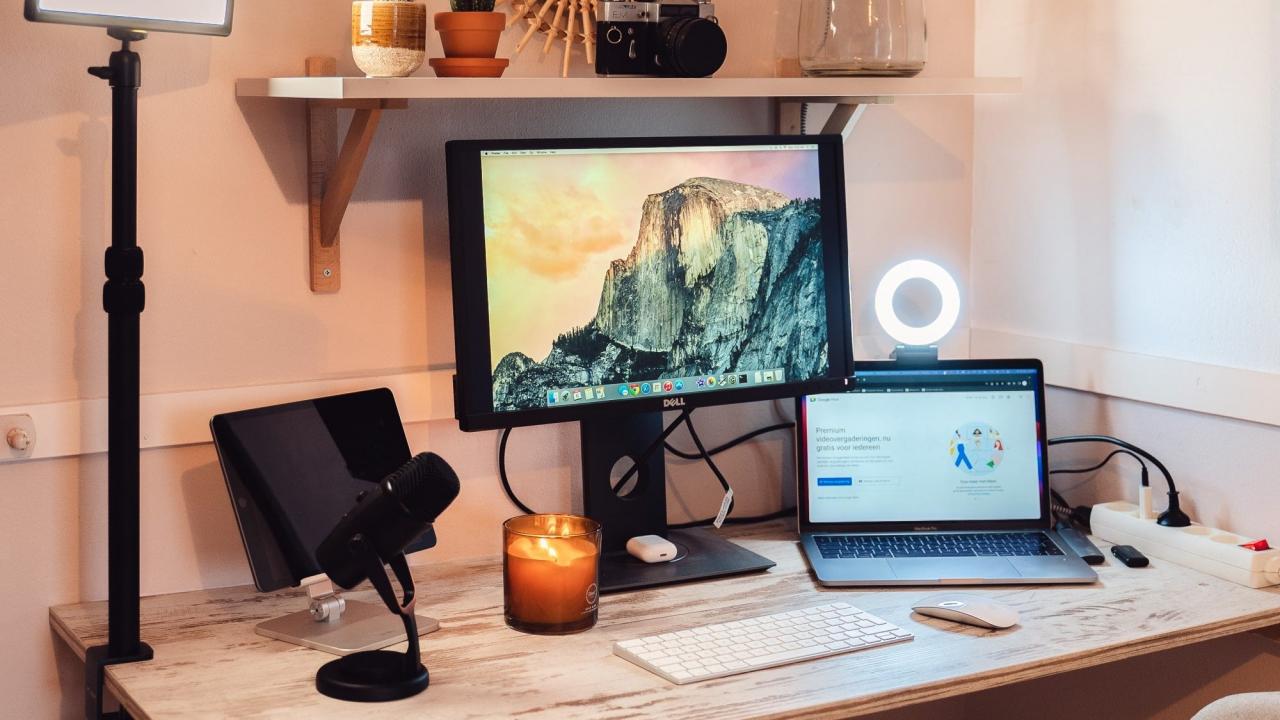Ultimate Guide to Designing a Perfect Home Workspace Setup: Transforming your home into a haven of productivity isn’t just about aesthetics; it’s about creating a space that fuels your focus and well-being. This guide dives deep into the ergonomics, technology, lighting, organization, and personalization needed to craft the ultimate workspace, ensuring you’re comfortable, efficient, and inspired to conquer your workday – from the perfect chair to the ideal lighting and even the best ways to organize your digital chaos.
We’ll cover everything from setting up your monitor for optimal posture to choosing the right productivity software and minimizing distractions. Learn how to create a workspace that reflects your personal style while maximizing efficiency and promoting a healthy work-life balance. Get ready to design a home office that’s not just functional, but truly
-yours*.
Ergonomics and Physical Setup

Creating a perfect home workspace isn’t just about aesthetics; it’s about prioritizing your physical well-being. A poorly designed setup can lead to discomfort, pain, and decreased productivity. Investing time in ergonomic considerations is an investment in your health and efficiency. Let’s delve into the key aspects of setting up a workspace that supports your body and boosts your performance.
Ergonomic Workspace Checklist
Before diving into specific components, a systematic evaluation is crucial. This checklist helps you assess your current setup and identify areas for improvement.
- Chair: Does your chair provide adequate lumbar support, adjustable height, and armrests? Is it comfortable for extended periods?
- Desk: Is your desk height appropriate for your chair and monitor? Does it offer sufficient space for your equipment and work materials?
- Monitor Placement: Is your monitor positioned at eye level, arm’s length away, and directly in front of you to minimize neck strain?
- Keyboard and Mouse: Are your keyboard and mouse positioned to avoid reaching or straining your wrists and arms? Are your elbows bent at a 90-degree angle?
- Lighting: Is your workspace well-lit, minimizing eye strain and glare from your monitor?
- Posture: Do you maintain good posture while working, sitting upright with your feet flat on the floor?
- Breaks: Do you take regular breaks to stretch and move around, preventing stiffness and fatigue?
Ideal Chair Features for Extended Work Sessions
Your chair is the foundation of your ergonomic setup. Investing in a high-quality ergonomic chair is a worthwhile expense. Key features to look for include:
- Adjustable Height: Allows you to customize the chair’s height to ensure your feet are flat on the floor and your thighs are parallel to the ground.
- Lumbar Support: Provides crucial support for your lower back, preventing slouching and back pain. Look for adjustable lumbar support for personalized comfort.
- Adjustable Armrests: Allow you to position your arms comfortably, reducing shoulder and neck strain. Consider height and width adjustability.
- Breathable Fabric: Prevents overheating and discomfort during extended use. Mesh or breathable fabric is preferred over leather or vinyl.
- Headrest (Optional): Provides additional support for your neck and head, especially beneficial for those who tend to slouch.
Proper Monitor Placement and its Impact on Posture
Monitor placement significantly impacts posture and eye strain. Incorrect positioning can lead to neck pain, headaches, and eye fatigue. Ideally, your monitor should be:
- At Eye Level: The top of your monitor should be roughly at eye level to prevent you from constantly looking up or down.
- Arm’s Length Away: This distance helps reduce eye strain and allows for comfortable viewing.
- Directly in Front: Avoid placing your monitor off to the side, forcing you to twist your neck and potentially causing strain.
Comparison of Desk Types
Different desk types cater to various preferences and needs. The choice depends on your individual workspace and working style.
| Desk Type | Pros | Cons | Ideal For |
|---|---|---|---|
| Sitting Desk | Affordable, readily available, comfortable for some | Can promote sedentary behavior, potential for back problems if not used ergonomically | Users who prefer traditional seated work |
| Standing Desk | Promotes movement, reduces sedentary behavior, can improve energy levels | Can be expensive, may cause fatigue if not used gradually, requires sufficient space | Users who want to incorporate more movement into their workday |
| Adjustable Desk (Sit-Stand) | Combines the benefits of sitting and standing, allows for flexibility throughout the day | Most expensive option, can be bulky, requires careful setup and adjustment | Users who want the most flexibility and want to mitigate the downsides of both sitting and standing desks. |
Technology and Software
A well-designed workspace isn’t just about the physical setup; it’s also about optimizing your digital environment. The right technology and software, coupled with efficient workflows, can significantly boost your productivity and minimize distractions. This section explores strategies for maximizing your tech to create a seamless and efficient home workspace.
Computer File Organization
Effective file management is crucial for a productive workspace. A disorganized digital landscape can lead to wasted time searching for documents and increased stress. Implementing a clear and consistent file structure is key. Consider using a hierarchical system based on projects, clients, or topics. For example, you could have a main folder for “Work,” with subfolders for each ongoing project, further categorized by document type (e.g., “Project Alpha/Documents,” “Project Alpha/Presentations”).
Regularly review and purge outdated files to prevent clutter. Utilizing cloud storage services like Google Drive or Dropbox allows for easy access and backup of your important files, regardless of your location. Employing descriptive file names, like “Client X Proposal_Final.docx” instead of “doc1.docx,” ensures quick identification.
Dual-Monitor Setup and Configuration
A dual-monitor setup dramatically expands your screen real estate, allowing for multitasking and improved workflow efficiency. Imagine having your email client on one screen and your primary work application on the other, minimizing the need to constantly switch between windows. For optimal configuration, consider matching monitor sizes and resolutions for a seamless visual experience. Extend your desktop across both monitors, rather than mirroring, to maximize usable space.
Experiment with different monitor placements – some users prefer a side-by-side arrangement, while others prefer one monitor positioned above the other. Adjust screen brightness and contrast for comfortable viewing. Proper cable management behind your monitors will help keep your workspace tidy and organized.
Email and Notification Management
Emails and notifications can be major sources of distraction. Establishing a clear workflow for managing them is essential. Schedule specific times for checking email, rather than constantly monitoring your inbox. Utilize features like email filters and folders to organize incoming messages. For example, create filters to automatically sort emails from specific senders or containing certain s into designated folders.
Turn off non-essential notifications on your computer and phone to minimize interruptions. Consider using notification management tools that allow you to batch process alerts at designated times. Prioritize tasks based on urgency and importance, responding to emails strategically rather than reactively.
Productivity Software Applications
Various productivity software applications offer different benefits and drawbacks. For example, project management software like Asana or Trello provides tools for task organization, collaboration, and progress tracking. Note-taking applications like Evernote or OneNote facilitate efficient capture and organization of ideas and information. Consider your specific needs and workflow when selecting software. While some applications offer extensive features, they may also have a steeper learning curve.
Others may be simpler to use but lack advanced functionality. Experiment with free trials or free versions of different applications to find the best fit for your individual requirements. Remember to regularly update your software to benefit from new features and security patches.
Lighting and Environment
Creating the perfect home workspace isn’t just about ergonomics and tech; it’s about crafting an environment that nurtures focus and well-being. The right lighting and a thoughtfully designed atmosphere can significantly boost productivity and reduce stress, transforming your workspace from a mere functional area into a haven of creativity and efficiency.
Ideal Lighting Setup
Proper lighting is crucial for eye health and overall comfort. A balanced approach combining natural and artificial light sources is ideal. Maximize natural light by positioning your desk near a window, but avoid direct sunlight which can cause glare and overheating. Supplement natural light with adjustable artificial lighting. A combination of ambient lighting (overall room illumination), task lighting (focused light on your work surface), and accent lighting (to highlight specific areas) creates a versatile and comfortable workspace.
Consider using a desk lamp with a flexible arm and adjustable brightness, allowing you to customize the light intensity to your needs throughout the day. Full-spectrum LED bulbs mimic natural daylight, reducing eye strain and promoting better focus.
Impact of Color Psychology on Productivity and Well-being
Color significantly impacts mood and productivity. Cool colors like blues and greens are generally associated with calmness and focus, making them suitable for workspaces where concentration is key. However, excessive use of cool colors can lead to a sterile or cold feeling. Warm colors like yellows and oranges can stimulate creativity and energy but should be used sparingly to avoid overstimulation.
A balanced approach, perhaps incorporating a calming blue backdrop with accents of energizing yellow, can create a workspace that promotes both focus and inspiration. Consider the specific tasks you perform and choose colors that align with those needs. For example, a graphic designer might benefit from a workspace with vibrant, inspiring colors, while a writer might prefer a calmer, more neutral palette.
Noise-Canceling Strategies
Distracting noises can significantly hinder productivity. Implementing noise-canceling strategies is vital for maintaining focus. Consider using noise-canceling headphones or earbuds to block out external sounds. If headphones aren’t suitable, explore sound-absorbing materials such as rugs, curtains, or acoustic panels to dampen ambient noise. White noise machines or calming nature sounds can also mask distracting noises and create a more peaceful work environment.
Strategically positioning your workspace away from noisy areas within your home, such as the kitchen or living room, can also significantly reduce distractions. A quiet, dedicated workspace is a cornerstone of efficient work.
Incorporating Plants and Natural Elements
Introducing plants and natural elements into your workspace not only enhances aesthetics but also improves air quality and reduces stress. Plants such as snake plants, spider plants, and peace lilies are known for their air-purifying qualities. Their presence can also create a more calming and visually appealing environment. Natural materials like wood, bamboo, or stone can add warmth and texture to your workspace, contributing to a more inviting and comfortable atmosphere.
Even a small collection of carefully chosen plants can make a big difference in the overall mood and functionality of your home office. Consider the size of your workspace and choose plants accordingly, ensuring they receive adequate sunlight and water.
Organization and Storage

A well-organized workspace isn’t just aesthetically pleasing; it’s crucial for boosting productivity and reducing stress. A chaotic desk can lead to wasted time searching for items and a feeling of overwhelm. This section focuses on practical strategies for organizing both physical and digital aspects of your home office, maximizing space efficiency, and maintaining a clutter-free environment.
Effective organization hinges on a strategic blend of physical and digital systems. Think of it as creating a workflow that minimizes friction and maximizes your ability to focus on the tasks at hand. This involves thoughtful choices in storage solutions, a clear system for filing documents, and a commitment to regular decluttering.
Physical Document Organization
Implementing a robust system for managing physical paperwork is essential. This might involve a combination of filing cabinets, shelves, and desk organizers. Prioritize frequently accessed documents, placing them within easy reach. Less frequently used materials can be stored in more distant locations. Consider color-coded folders or labels for quick identification.
Regularly review your files, purging outdated or irrelevant documents to prevent unnecessary clutter. A good rule of thumb is to digitize documents whenever possible, freeing up valuable physical space.
Digital Document Management
Maintaining a well-organized digital workspace is equally critical. Cloud storage services like Google Drive, Dropbox, or OneDrive offer excellent solutions for backing up and organizing digital files. Utilize a consistent folder structure, mirroring your physical filing system if possible, for easy navigation. Employ descriptive file names to facilitate quick searches. Regularly back up your data to prevent loss due to hardware failure or other unforeseen circumstances.
Consider using a cloud-based note-taking app such as Evernote or OneNote to consolidate project notes, meeting minutes, and other relevant information.
Creating the ultimate guide to designing a perfect home workspace setup means considering every detail, from ergonomic chairs to ambient lighting. Think about the level of comfort and inspiration you want – a space that rivals the luxurious serenity found in some of the world’s most luxurious hotels providing unforgettable experiences and memories. After all, a productive workspace should be as inspiring as a memorable vacation, boosting your creativity and efficiency.
Decluttering and Workspace Maintenance
A clean and organized workspace is paramount for maintaining focus and productivity. Regular decluttering is key to achieving this. Dedicate specific time slots each week for tidying your workspace. The “two-minute rule” can be surprisingly effective: if a task takes less than two minutes, do it immediately. This prevents small tasks from accumulating into larger, more daunting chores.
For larger decluttering projects, employ the “one in, one out” rule – for every new item you bring into your workspace, remove an existing item. This prevents the accumulation of unnecessary items and keeps your space feeling fresh and uncluttered.
Maximizing Space Efficiency with Storage Solutions
Strategic use of storage solutions is critical for maximizing space efficiency in a home office. Vertical storage, such as tall bookshelves or filing cabinets, utilizes wall space effectively. Drawer organizers and desk trays can help keep smaller items neatly contained. Under-desk storage can provide additional space for less frequently used items. Consider using stackable containers to maximize vertical space in cupboards or shelves.
Investing in multi-functional furniture, such as desks with built-in storage or ottomans with storage compartments, can also help to optimize space.
Visual Representation of an Organized Workspace
Imagine your workspace divided into distinct zones, each with a specific purpose.
Need the ultimate guide to designing a perfect home workspace setup? You’ll find inspiration for your ideal home office at the home and garden show , where you can discover the latest in furniture, tech, and organization solutions. From ergonomic chairs to clever storage ideas, the show is a treasure trove of ideas to help you create the productive and stylish workspace you’ve always dreamed of.
So, get ready to transform your home office!
- Central Work Zone: This area houses your computer, keyboard, mouse, and other essential work tools. It should be spacious enough to allow for comfortable movement and should be free of clutter.
- Filing and Storage Zone: Located nearby, this area contains filing cabinets, shelves, or other storage solutions for both physical and digital documents. Color-coded folders and clear labels help maintain order.
- Supply Zone: This area holds stationery, printer paper, and other frequently used supplies. Keep it well-stocked but not overcrowded.
- Break Zone: A small area designated for relaxation and short breaks. This could include a comfortable chair, a small plant, or a personal item that inspires you.
Personalization and Aesthetics

Transforming your workspace from a functional area into a haven of productivity and inspiration hinges on personalization. A space that reflects your individual style not only boosts your mood but also enhances focus and creativity. Think of it as an extension of yourself, tailored to optimize both your work and well-being.Your home workspace should be more than just a place to get things done; it should be a reflection of who you are and what inspires you.
Incorporating personal touches fosters a sense of ownership and comfort, making it a space you genuinely enjoy spending time in. This positive association directly translates to increased productivity and a more fulfilling work experience.
Personal Touches for a Visually Appealing Workspace
Adding personal touches is about infusing your personality into your workspace’s design. This can involve anything from displaying cherished artwork and family photos to incorporating plants, inspirational quotes, or objects that hold sentimental value. For example, a collection of vintage typewriters could evoke a sense of nostalgia and creativity for a writer, while a curated display of succulents might bring a calming, minimalist aesthetic to a designer’s workspace.
The key is to choose items that resonate with you and spark joy. Consider the overall style and color palette of your space when selecting these items to ensure a cohesive and harmonious look.
The Importance of a Workspace Reflecting Personal Style
Creating a workspace that aligns with your personal style and preferences is crucial for well-being and productivity. A space that feels authentic to you fosters a sense of calm and control, reducing stress and promoting a positive work environment. If you prefer a minimalist aesthetic, a clutter-free space with a neutral color palette might be ideal. Conversely, a vibrant, eclectic style might suit someone who thrives in a more stimulating and visually rich environment.
The goal is to design a space that supports your individual needs and preferences, ultimately leading to a more productive and enjoyable work experience. Consider your personality type and how different design elements might affect your mood and focus.
Mood Board: Design Styles for a Home Workspace
A mood board can be a powerful tool for visualizing your ideal workspace. It allows you to experiment with different design styles and color palettes before making any significant changes.
- Minimalist: Characterized by clean lines, neutral colors (whites, grays, beiges), and a focus on functionality. Think sleek desks, minimalist shelving, and a limited number of carefully chosen accessories. This style promotes a sense of calm and focus.
- Bohemian: Embraces eclecticism, layering textures and patterns. Think rich fabrics, vibrant colors, global-inspired accents, and plenty of plants. This style fosters creativity and a sense of freedom.
- Scandinavian: Emphasizes functionality, simplicity, and natural light. Think light wood furniture, white walls, and pops of color. This style creates a bright, airy, and inviting workspace.
- Modern Industrial: Combines raw, industrial elements with modern design. Think exposed brick, metal accents, and sleek furniture. This style is bold and edgy, perfect for creative individuals.
- Traditional: Features classic design elements such as rich wood tones, ornate details, and comfortable seating. This style creates a sophisticated and timeless workspace.
Creating a Workspace that Promotes Creativity and Focus
Designing a workspace that nurtures both creativity and focus requires a thoughtful approach. To foster creativity, incorporate elements that stimulate the senses, such as inspiring artwork, plants, and textured materials. A comfortable chair and good lighting are essential for prolonged periods of work. On the other hand, minimizing distractions is crucial for maintaining focus. This might involve creating a dedicated workspace free from interruptions, utilizing noise-canceling headphones, and employing time management techniques.
The balance between stimulation and tranquility is key to creating a truly effective workspace. For instance, a vibrant color palette on one wall might stimulate creativity, while a calmer, neutral area could be designated for focused work.
Maintaining a Healthy Workspace: Ultimate Guide To Designing A Perfect Home Workspace Setup

Creating a productive home workspace isn’t just about aesthetics and efficiency; it’s crucial to prioritize your well-being to prevent burnout and maintain peak performance. A healthy workspace fosters a positive work-life balance, ensuring you can thrive both professionally and personally. This section focuses on practical strategies to safeguard your physical and mental health while working from home.
Preventing Eye Strain and Fatigue
Prolonged screen time is a common culprit for eye strain and fatigue. Implementing preventative measures is essential for maintaining eye health and preventing headaches. Regularly taking breaks, adjusting screen brightness and positioning, and practicing the 20-20-20 rule are highly effective. The 20-20-20 rule suggests every 20 minutes, look at an object 20 feet away for 20 seconds. This simple exercise helps relax your eye muscles.
Additionally, ensuring adequate lighting in your workspace, minimizing glare from windows or light sources, and using blue light filtering glasses can significantly reduce eye strain. Regular eye exams are also recommended to address any underlying issues.
The Importance of Regular Breaks and Stretching Exercises
Sitting for extended periods can lead to muscle stiffness, back pain, and reduced blood circulation. Incorporating regular breaks and stretching exercises into your workday is vital for maintaining physical well-being and preventing these issues. Aim for short, 5-10 minute breaks every hour to stand up, walk around, and stretch your limbs. Simple stretches like neck rolls, shoulder shrugs, and wrist rotations can alleviate tension and improve circulation.
Consider incorporating light exercises like walking or cycling during your lunch break to boost energy levels and improve overall fitness. Regular physical activity outside of work hours further complements this approach.
Mindfulness and Relaxation Techniques, Ultimate guide to designing a perfect home workspace setup
Incorporating mindfulness and relaxation techniques into your daily routine can significantly reduce stress and improve focus. A simple schedule might include a 5-minute meditation session at the start of the day to center yourself and set a positive intention. Short breathing exercises throughout the day can help manage stress and improve concentration. Consider incorporating a longer relaxation session, such as yoga or deep breathing, during your lunch break or at the end of the workday.
These practices promote mental clarity, reduce anxiety, and improve overall well-being, leading to increased productivity and a healthier work-life balance. Even a few minutes of mindful breathing can make a difference.
Healthy Snacks and Hydration Strategies
Maintaining energy levels throughout the day requires a strategic approach to snacking and hydration. Avoid sugary snacks and processed foods that lead to energy crashes. Instead, opt for nutrient-rich options like fruits, vegetables, nuts, and yogurt. Keep a water bottle nearby and sip water consistently throughout the day. Dehydration can lead to fatigue and reduced cognitive function.
Plan your snacks and meals to ensure you’re consistently fueled throughout the workday. For example, a morning snack of Greek yogurt with berries provides sustained energy, while an afternoon snack of almonds and an apple offers a healthy boost without the sugar rush. Regular hydration, coupled with a balanced diet, significantly contributes to a more productive and energetic workday.